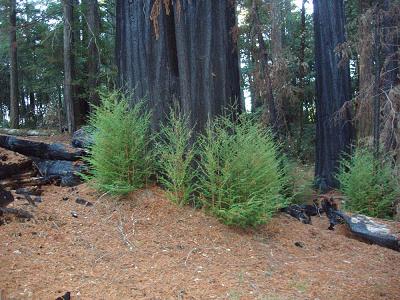|
The Coast Redwood Forest
A prominent redwood ecologist once remarked that to be considered a redwood forest all we need is to find is a single redwood tree. Tourists flock to see the towering old growth, loggers have long sought the wood for its special properties, and according to Woody Guthrie's famous folk song, "This Land is Your Land", the redwood forest is deeply embedded within our national character.
Part of our fascination with this species is that it has a particularly limited distribution. True to its name, the coast redwood hugs the Pacific coast, extending from near the Oregon-California border in the north to the Santa Lucia Mountains of Monterey County, California in the south. The interior limit of coast redwood is irregular, extending from 8 to 39 kilometers inland from the coast. More...
The most spectacular and extensive unlogged forests are found in the northern third of the range (right) where numerous reserves have been acquired through public funds and the efforts of conservation organizations, such as Save The Redwoods League.
Forests that form nearly exclusive canopies of coast redwood are relatively rare, even in the humid north. These stands are confined to alluvial flats and moist slopes. Alluvial sites promote redwood dominance because frequent flooding reduces the competitive ability of other conifers like Douglas fir (Pseudotsuga menziesii), grand fir (Abies grandis) and western hemlock (Tsuga heterophylla). Valley sites that are protected from high severity fire and wind allow redwood to grow old. With a potential life span well over 1000 years and their ability to grow much taller than other species, redwood gain and retain dominance for centuries. |
|
The forests that have formed on slopes are different than alluvial valley forests. Rarely dominated by redwood, forested slopes often have as many large Douglas fir as redwood. The importance of Douglas fir increases toward dry south-facing slopes along with the importance of hardwoods. The two leading hardwood species, tanoak (Lithocarpus densiflorus) and madrone (Arbutus menziesii), are sprouters, like coast redwood. This sprouting habit is also shared by evergreen huckleberry (Vaccinium ovatum), the dominant understory shrub on dry slopes. Sword fern (Polystichum munitum) often forms extensive thickets on humid sites and alluvial flats. The importance of sprouters in these forests helps maintain a high degree of vegetational stability after fire, wind, logging or floods.
The strong topographic gradients described above are directly and indirectly the result of differences in solar radiation. Dryer exposures increase evapotranspiration stress and are normally associated with more intense fire severity. Upper slopes are also often more exposed to winter winds, and the high canopy turnover on these sites due to both fire and wind allows resprouting hardwoods and seeded conifers to establish and persist.
In addition to local topographic gradients, coast redwood's vegetation exhibits remarkable differences along the coast-to-interior gradient. High winds and salt spray limit how close redwood gets to the shoreline, but near-coastal sites were often dominated by redwood. Redwood's importance generally decreases eastward, becoming more confined to wetter sites and lower slopes. This change relates to a drop in the frequency of fog-stratus cover during the summer and greater annual temperature fluctuations related to increased distance from moderating coastal waters.
A third widely recognized vegetational gradient is latitudinal. In the humid north, redwood often thrives on dry to moderately dry upper slopes, but in the southernmost portion of its range, it is confined to the valley drainages. To some degree, this latitudinal gradient is mirrored in the easternmost portion of the range in the north, where scattered redwood outliers are confined to moist streamside locations.

Unusual among northern hemisphere conifers, coast redwood is a strong sprouter after disturbance. Numerous studies indicate that a tree's sprouting response after logging generally decreases with tree size and age, and similar patterns likely exist range-wide after damage from fire or wind. Although seeding also reportedly decreases with age, the opportunity for non-clonal replacement increases the longer an individual trees lives.
In addition to sprouting from the tree's underground lignotuber (above), coast redwood commonly reprouts along its limbs after foliage loss from fire or wind, and will sprout continuously along its bole after top breakage or an increase in light due to gap formation or selective logging.
Related Pages:
Steve Norman
|
|

